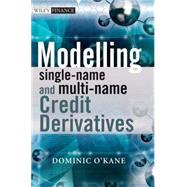Modelling Single-Name and Multi-Name Credit Derivatives
, by O'Kane, Dominic- ISBN: 9780470519288 | 0470519282
- Cover: Hardcover
- Copyright: 8/4/2008
The credit derivatives market has grown significantly and rapidly over the past 8 years. However, it is only in the last 4 years that we have seen the advent of the CDS index portfolios such as CDX and iTraxx and their rapid domination of the market. These have revolutionised the credit derivatives market, increasing liquidity and significantly broadening the user base. On top of this, we also have the arrival of CDO tranches linked to these portfolios which has resulted in large and liquid market in default correlation, something that was almost unimaginable 4 years ago. This has created significant challenges for credit modellers as it has essentially rendered earlier correlation models unusable. The search for new approaches has produced a set of new and competing models, all vying to become the new standard. Other products have arrived which have also presented new challenges to credit modellers. These include constant maturity default swaps, options on CDS indices, and CDO squareds, to name just a few. This book covers all of the theory of credit in detail and also covers all of the new developments listed above. Most of the current treatments of the credit derivatives markets are authored by academics (Schonbucher, Duffie&Singleton, Hull) and so are strong on the mathematics. They are usually weak on products descriptions, discussions of the risks, realistic examples, development of model intuition and discussions of the practicalities of implementing the model for the pricing and risk management of credit derivatives in a real industrial setting like an investment bank. Other treatments by practitioners (Chaplin, Tavakoli) tend to be out of date and tend not to get highly technical in the mathematical and implementational detail. O'Kane's aim is to fill the gap by with something which is technical, practical and accessible in the sense that the mathematical treatment is more of a physics/engineering style. It should therefore be useful to the practising quant, risk-manager or student seeking information on how these models are selected and used in reality.







